Promising aquaculture technology can help in the treatment and prevention of fish infections caused by microbial pathogens
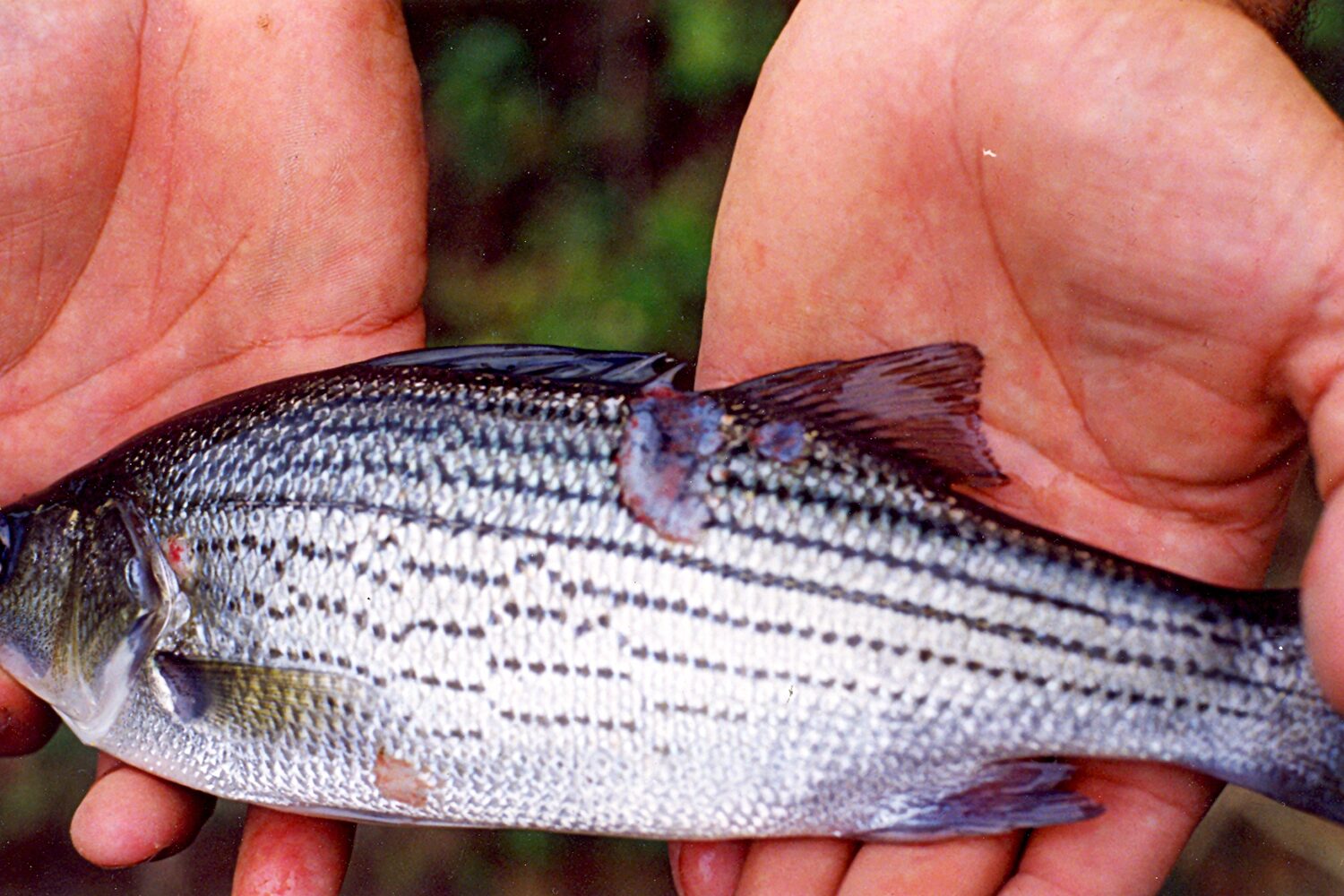
Alternative technologies are needed for controlling pathogenic infections in cultured fish, and Antimicrobial Photodynamic Therapy (aPDT) has recently emerged as one of the technologies that can be successfully applied for the treatment of bacterial diseases and for the prevention of antibiotic resistance. This therapy involves the use of various chemicals called photosensitizing agents, together with light, in an oxygen-rich environment to kill pathogenic bacteria.
aPDT applies a photosensitizer – such as methylene blue, riboflavin, curcumin and several others – which, after cellular uptake by bacteria, is irradiated with light (of appropriate wavelength) promoting chemical changes in the photosensitizer inside the bacterial cells, eventually producing reactive oxygen species (ROS) such as hydrogen peroxide and others which cause pathogen cell damage and death.
This article – summarized from the original publication (Dube, E. and G.E. Okuthe. 2024. Applications of Antimicrobial Photodynamic Therapy in Aquaculture: Effect on Fish Pathogenic Bacteria. Fishes 2024, 9(3), 99) – provides an overview of the use of aPDT against fish pathogenic bacteria and its potential of innovative designs towards the development of sustainable aquaculture.
For detailed information on this technology, the various photosensitizers utilized for aPDT against fish pathogens, potential applications of aPDT in aquaculture, and other relevant information, refer to the original publication.
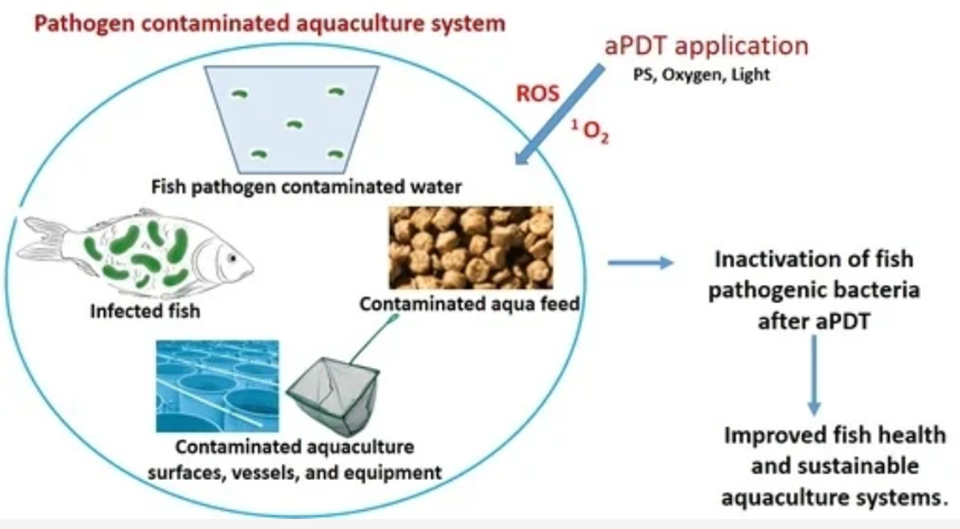
Application of aPDT in aquaculture
The application of aPDT for addressing deep tissue infections is constrained, with only a few documented attempts involving animal models like mice. However, there is a noticeable lack of scientific research attention on the treatment of fish diseases through aPDT, which may be attributed to the localized delivery of visible light. Researchers have proposed that fish with superficial infections, ulcers or lesions can be incubated in the dark and in water with dissolved photosensitizer. Subsequent irradiation with light should result in total recovery, as illustrated in Fig. 2. However, this area of research still needs to be thoroughly investigated, considering the sensitivity of fish to changing environmental conditions, especially sudden changes in water conditions.
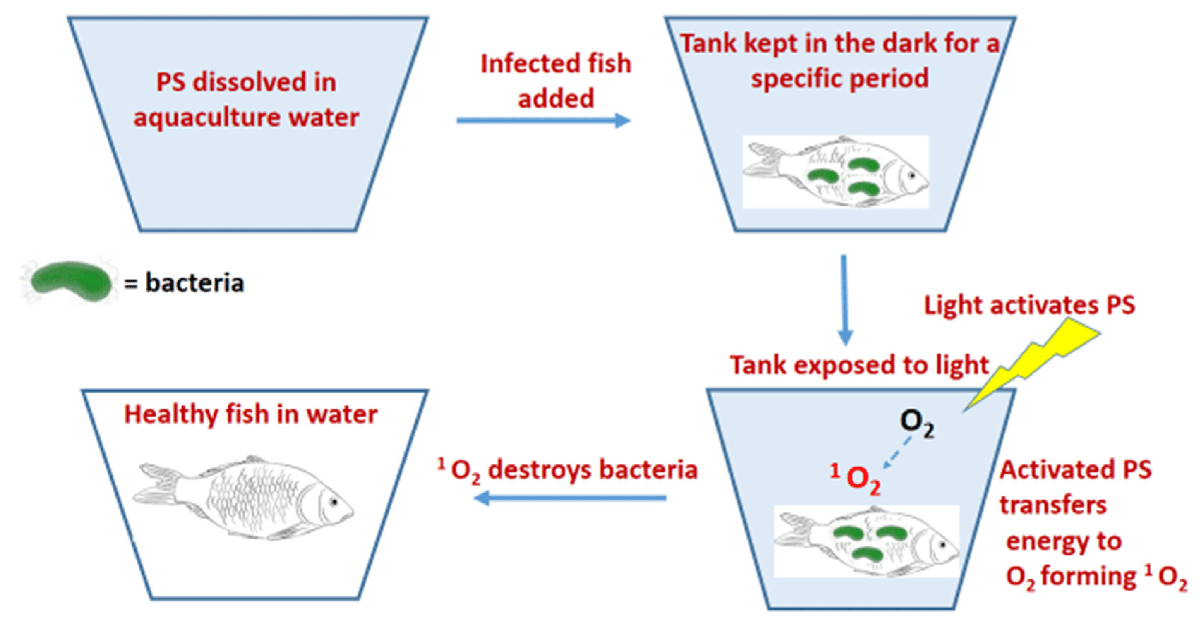
Water quality is of importance in fish farms as it impacts the growth and health of fish. Fish not only live but feed and excrete waste in water. The residual feed, defecated waste and other water pollutants afford microorganisms favorable habitats. The water must be regularly cleaned and disinfected to reduce microbial infections. aPDT has been utilized for the disinfection of aquaculture water by adding the photosensitizer to water or embedding the photosensitizer in a solid membrane before irradiation with light of an appropriate wavelength. The irradiated light should be able to penetrate into the water (thus, water should be free of suspended matter) for the activation of the photosensitizer, and the water should be sufficiently oxygenated.
Magnetic nanoparticles have been linked to photosensitizers for easy recovery of the photosensitizers from the water matrix using a magnet, allowing for recycling and reuse. Fig. 3 illustrates the use of a magnetic photosensitizer in disinfecting aquaculture water, together with the recovery of the photosensitizer after disinfection using a magnet.
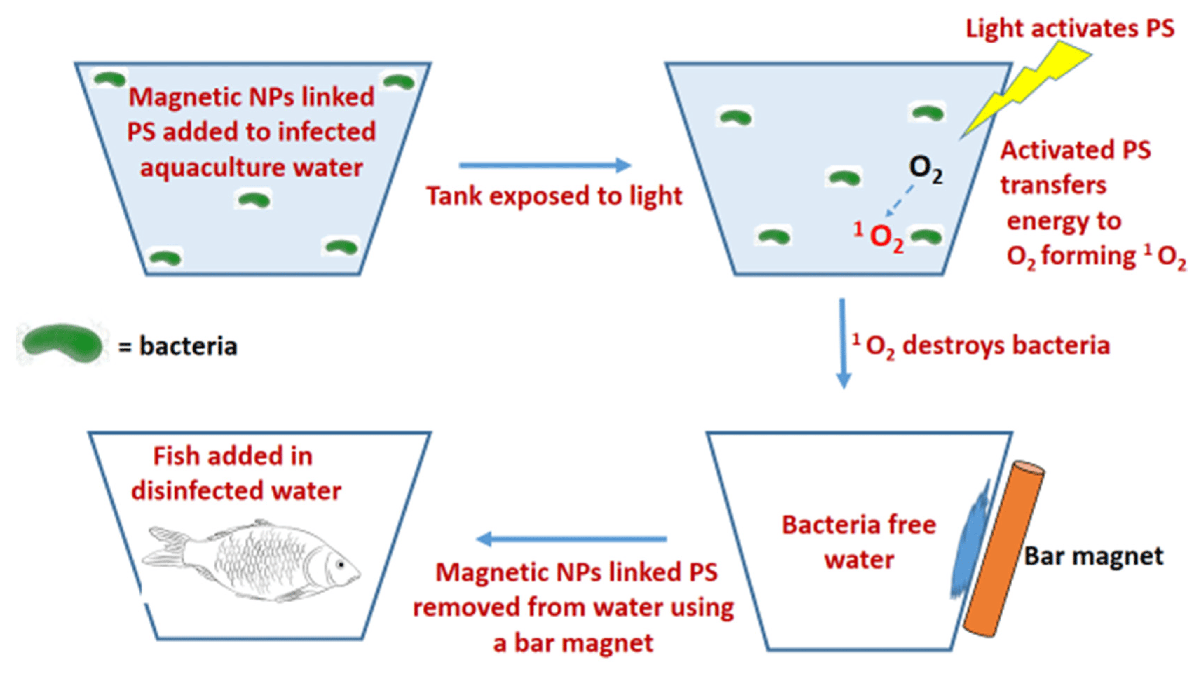
Researchers have demonstrated the photoinactivation of bacteria like Staphylococcus aureus and Escherichia coli using a magnetic photosensitizer (phthalocyanine linked to iron oxide nanoparticles), together with the recyclability of the photosensitizer. Photosensitizers have also been immobilized on multi-walled carbon nanotubes for enhanced antibacterial activity (through photodynamic and photothermal therapy) while allowing for recovery and reuse in water and surface disinfection, making them cost-effective and environmentally friendly. For sustainability, natural light from the sun can be considered as it can penetrate deep and be utilized for large ponds.
Disinfection of surfaces and equipment is a preventive measure to avoid opportunistic pathogens, including their transmission within the aquaculture facilities. After cleaning, surfaces, vessels, and equipment can be exposed to the photosensitizer and light for bacterial inactivation through aPDT, and self-disinfecting surfaces that utilize aPDT have been reported. For instance, researchers have utilized a phenoxy-substituted zinc phthalocyanine as a photosensitizer to fabricate cellulose acetate self-disinfecting films, which continuously generated singlet oxygen (1O2; the lowest excited state of the diatomic oxygen molecule) for over six months under continuous exposure to room light. Self-disinfecting aPDT coatings can, thus, be applied on aquaculture surfaces for natural light activation.
Aquafeed is formulated from plants and animal sources, including seaweed and microalgae. These can be contaminated with bacteria before harvesting, during drying, processing, packaging, storage and transportation. To avoid the introduction of bacterial pathogens into the aquaculture production systems, the fish feed needs to be disinfected, and researchers have shown aPDT to have potential for the disinfection of fish feed.
Researchers have also demonstrated the ability of aPDT to disinfect microalgal aquafeed contaminated with the bacterium Vibrio campbellii. Other authors confirmed the ability of aPDT to destroy V. splendidus in both microalgal feed and tank water of oysters fed with the aPDT-treated microalgae, compared to those of oysters fed with an untreated diet.
AHPND is a chronic disease in Pacific white shrimp from Latin America
Advantages of aPDT
aPDT, being a non-antibiotic strategy for the treatment and prevention of infectious diseases, has several advantages over the use of antibiotics, because antibiotics can result in increased antibiotic-resistant bacteria together with the presence of residual antibiotics in food products.
aPDT has proven effective due to its broad spectrum of action since it can prevent infections caused by diverse organisms such as protozoa, viruses, fungi, parasites, and bacteria. This is because aPDT generates highly reactive oxygen species (ROS) that oxidize cellular components, rapidly inactivating the cells of these infectious organisms. aPDT can thus be used to control not only bacterial infection but a range of microbial infections.
aPDT has been shown to be effective against dangerous antibiotic-resistant bacteria. Additionally, there are no reports of the development of resistance against the photosensitizer, even after multiple therapy sessions. This could probably be because, unlike antibiotic therapy, aPDT treatment is too short for resistance to develop. Additionally, the generated ROS species can oxidize numerous targets on the bacterial cell structure and components, unlike antibiotics, which work on a specific target.
For the treatment of infections in fish, aPDT can be designed to have minimal effects and damage to the host tissue through photosensitizer and light dosage control, as well as the targeting of infected areas, ensuring that only pathogens are destroyed. Due to the short lifetime and high reactivity of singlet oxygen, photo-oxidative damage is restricted to the exposed infected parts.
Since the photosensitizer can also be embedded into polymers, aquaculture production systems that can kill microbes on their surfaces when activated by visible light can be designed. The self-disinfecting systems can reduce the spread of disease-causing microbes during production and processing. Additionally, natural light can be utilized for photosensitizer activation, making aPDT technology cost-effective. Embedding the photosensitizer onto polymeric materials prevents the release of the PS into the environment and promotes the reuse of the embedded photosensitizer.
aPDT can be combined with other technologies for enhanced efficiency. Combination therapy involving aPDT and antibiotics can be utilized, as aPDT therapy has been shown to induce damage to bacterial cell membranes, making the bacteria more susceptible to antibiotic treatment. Combining aPDT with nanomaterials not only enhances uptake by bacteria but can also lead to the synergistic effect of aPDT and photothermal therapy (PTT), as specific nanomaterials generate localized high temperatures upon light absorption.
Limitations of aPDT
The application of aPDT for treating fish infections is restricted to infected fish parts where light can reach, such as the skin. It will not work for systemic infections due to poor light accessibility.
Light penetrability is important for aPDT; hence, in aquaculture, the technique can only work in water that can allow light through (water should be clear and free of debris).
Considering that both faecal matter and uneaten food make the water in ponds murky, the material should be trapped and removed from the system for this technique to be effective. Thus, recirculating aquaculture systems might be required to continuously clean and disinfect aquaculture water.
aPDT is meant to target infectious microorganisms. However, it also damages unintended targets, such as fish tissue and beneficial microorganisms, due to its non-selectivity, which could manifest as side effects such as redness, swelling, and other allergic reactions.
Perspectives
aPDT can inactivate fish pathogenic bacteria, especially Gram-negative bacteria, one of the most important pathogens in aquaculture. Although there are no reports yet of its application in the treatment of fish infections, this technology has the potential for use in aquaculture, especially for surfaces, equipment and aquaculture water disinfection, as it has shown advantages compared to traditional antibiotics. This technology can be effective in water if utilized under recirculating aquaculture systems. This will enable the continuous removal of sludge, allowing for aPDT treatment of water and, ultimately, water reuse.
Though not reported yet in aquaculture, self-disinfecting surfaces utilizing aPDT can go a long way in managing bacterial pathogens. Photosensitizers can be embedded in surface coating materials for activation by light, including sunlight. The possibility of using sunlight and natural photosensitizers could make the technology cheaper. Additionally, the technology can reduce photosensitizer release to the environment and allow for the re-use of the photosensitizer.
Though some limitations of aPDT, especially when using natural photosensitizers, have been reported, ways to overcome these limitations can be designed. For instance, the use of several photosensitizers simultaneously can enhance antimicrobial effects. The combined photosensitizer may exhibit different photophysical and photochemical characteristics that complement each other. Additionally, aPDT has been combined with other antimicrobial therapies. The application of aPDT in the aquaculture industry still requires significant research and development efforts to ensure its efficacy, safety and scalability.
Now that you've reached the end of the article ...
… please consider supporting GSA’s mission to advance responsible seafood practices through education, advocacy and third-party assurances. The Advocate aims to document the evolution of responsible seafood practices and share the expansive knowledge of our vast network of contributors.
By becoming a Global Seafood Alliance member, you’re ensuring that all of the pre-competitive work we do through member benefits, resources and events can continue. Individual membership costs just $50 a year.
Not a GSA member? Join us.
Author
-
Edith Dube, Ph.D.
Corresponding author
Department of Biological & Environmental Sciences, Walter Sisulu University, P/B X1, Mthatha 5117, South Africa[97,122,46,99,97,46,117,115,119,64,101,98,117,100,101]
Related Posts
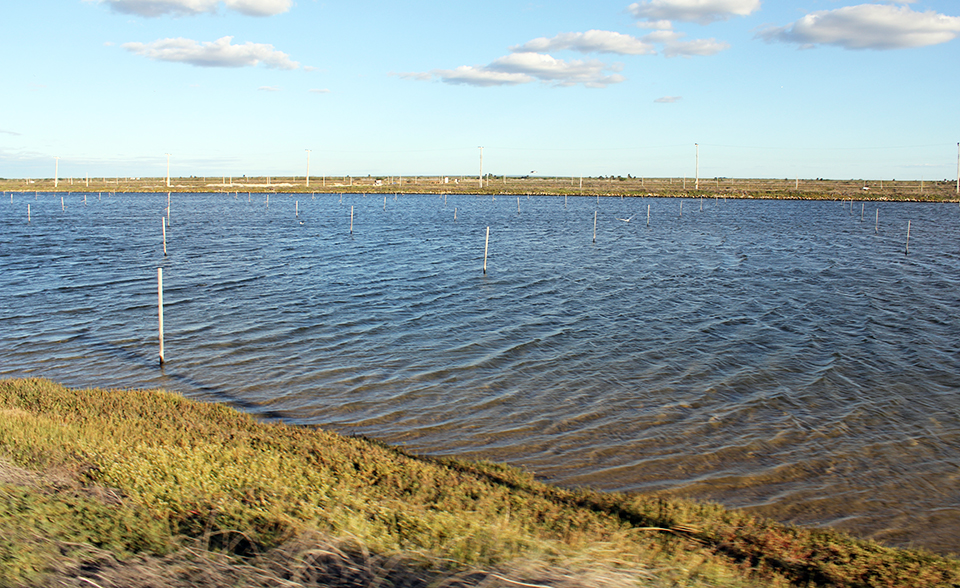
Health & Welfare
AHPN inferences based on behavior of vibrio bacteria
Vibrio parahaemolyticus, a strain of which is the cause of acute hepatopancreatic necrosis (AHPN), has both virulent and benign strains. This strain colonizes the stomachs of shrimp by the formation of a biofilm, which protects it from antibiotics and other potential treatments.
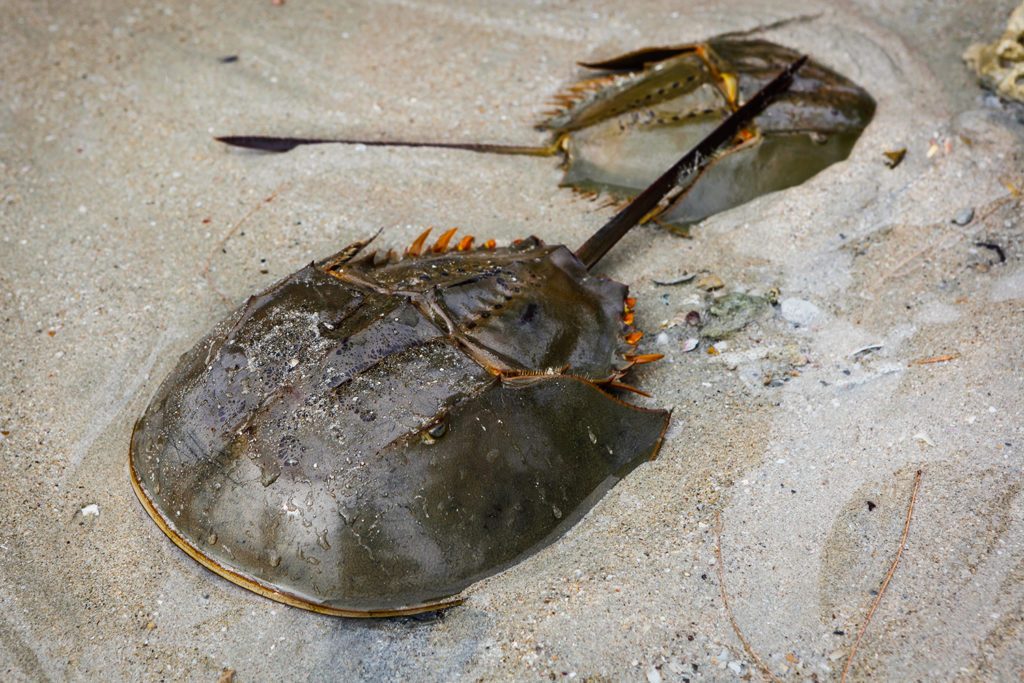
Health & Welfare
Can farming horseshoe crabs help the COVID-19 cause?
Already housing horseshoe crabs for medical purposes, researchers hope recirculating aquaculture systems will aid their coronavirus-fighting efforts.
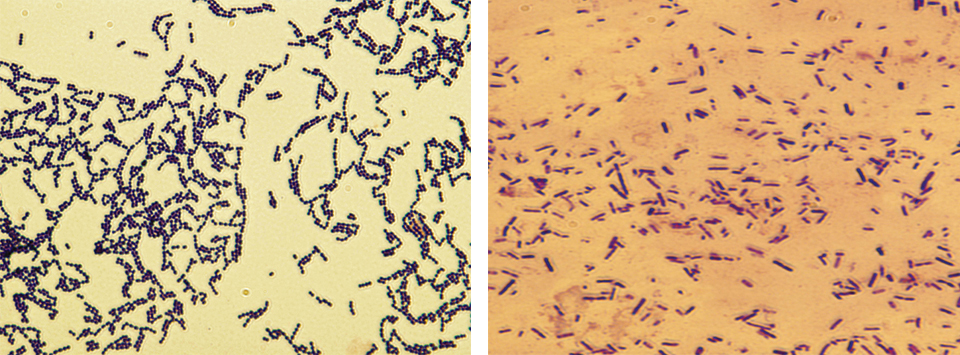
Health & Welfare
Developing live bacterial vaccines by selecting resistance to antibacterials
As wide use of antibiotics has led to antibiotic resistance in fish pathogens, vaccines present an alternative control method to prevent bacterial diseases.
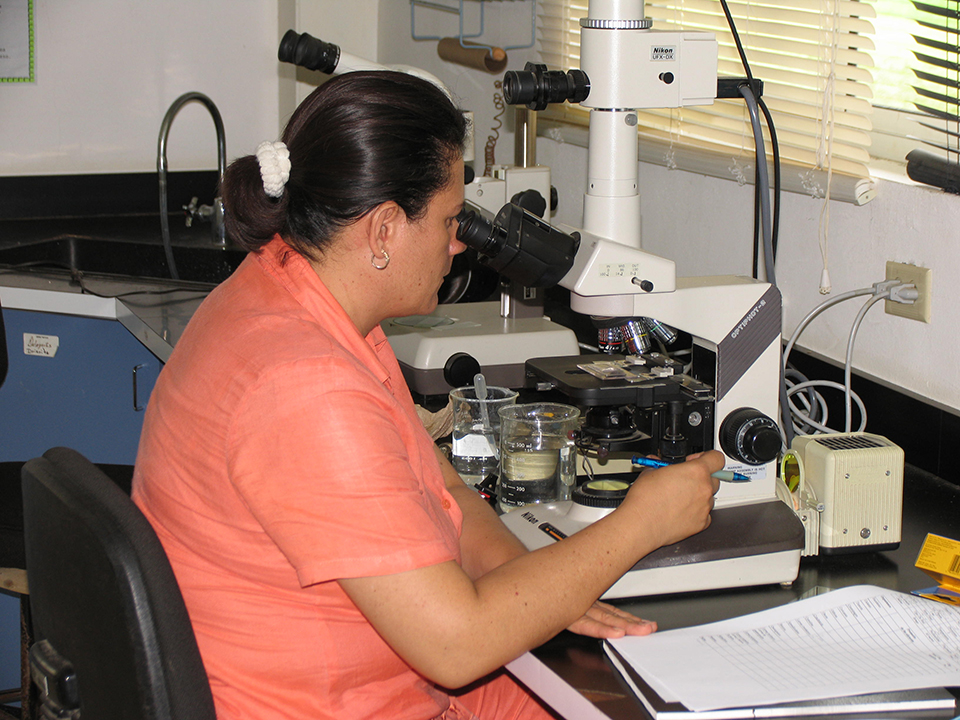
Health & Welfare
Antimicrobial resistance: Aquaculture to humans, humans to aquaculture?
The transfer of resistance from an aquaculture pathogen into a human enteric bacterium has been demonstrated in research and may be happening in the real-world environment.



